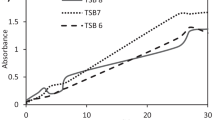Abstract
In this study, microcalorimetry combined with chemometric analysis was used to investigate the effects of angle and nail animal valuable drugs on Bacillus subtilis (B. subtilis) growth. The power–time curves of the growth metabolism of B. subtilis affected by Cornu Cervi Pantotrichum, Cornu Cervi Elaphi, Cornu Saigae Tataricae, cornu caprae hircus, Cornu Bubali, Squama Manis, and Carapax Trionycis were determined using a thermal activity monitor (TAM) air isothermal microcalorimeter, ampoule mode, at 37 °C. By analyzing these curves and some quantitative parameters using principal component analysis, the effects of the seven animal drugs on B. subtilis could be quickly evaluated from the change of the two main parameters, the maximum heat-flow power P 2m and total heat output Q t: Cornu Saigae Tataricae, cornu caprae hircus, Cornu Bubali, Squama Manis, and Carapax Trionycis inhibited the growth of B. subtilis, while Cornu Cervi Pantotrichum and Cornu Cervi Elaphi promoted the growth of B. subtilis. Further, the result of hierarchical clustering analysis showed that the drugs which promoted the growth of B. subtilis gathered in one cluster, the other drugs which inhibited the growth of B. subtilis gathered in the other cluster. All these illustrated that the internal characteristics of the seven animal drugs were different though they had similar resources and these drugs could be well clustered according the effects of them on B. subtilis growth with the help of chemometric methods. This study provided an useful idea of the combination of microcalorimetry and chemometric analysis for studying the effects of drugs on organisms.



Similar content being viewed by others
References
Wadsö I. Characterization of microbial activity in soil by use of isothermal microcalorimetry. J Therm Anal Calorim. 2009;95:843–50.
Kong WJ, Li ZL, Xiao XH, Zhao YL, Zhang P. Activity of berberine on Shigella dysenteriae investigated by microcalorimetry and multivariate analysis. J Therm Anal Calorim. 2010;102:33–6.
Zhao YL, Yan D, Wang JB, Zhang P, Xiao XH. Anti-fungal effect of berberine on Candida albicans by microcalorimetry with correspondence analysis. J Therm Anal Calorim. 2010;102:49–55.
Kong WJ, Jin C, Xiao XH, Zhao YL, Li ZL, Zhang P, Liu W, Li XF. Comparative study of effects of two bile acid derivatives on Staphylococcus aureus by multiple analytical methods. J Hazard Mater. 2010;179:742–7.
Wang J, Cheng DH, Zeng N, Xia HL, Fu Y, Yan D, Zhao YL, Xiao XH. Application of microcalorimetry and principal component analysis. J Therm Anal Calorim. 2010;102:137–42.
Yang LN, Sun LX, Xu F, Zhang J, Zhao JN, Zhao ZB, Song CG, Wu RH, Ozao R. Inhibitory study of two cephalosporins on E. coli by microcalorimetry. J Therm Anal Calorim. 2010;100:589–92.
Barros N, Salgado J, Rodrŕguez-Añón JA, Proupŕn J, Villanueva M, Hansen LD. Calorimetric approach to metabolic carbon conversion efficiency in soils. J Therm Anal Calorim. 2010;99:771–7.
Zhao YL, Wang JB, Zhang P, Li RS, Xiao XH. Microcalorimetric study of the opposing effects of ginsenosides Rg1 and Rb1 on the growth of mice splenic lymphocytes. J Therm Anal Calorim. 2011, doi: 10.1007/s10973-010-1003-6.
Montanari ML, Andricopulo AD, Montanari CA. Calorimetry and structure–activity relationships for a series of antimicrobial hydrazides. Thermochim Acta. 2004;417:283–94.
Bellavia G, Cordone L, Cupane A. Calorimetric study of myoglobin embedded in trehalose-water matrixes. J Therm Anal Calorim. 2009;95:699–702.
Wadso I. Microcalorimetric techniques for characterization of living cellular systems. Will there be any important practical application? Thermochim Acta. 1995;269:337–50.
Guo GY, Liu LS, Guo Y, Wang SJ, Jiang GZ. Development of pharmaco-study of animal drugs. Inf Trad Chin Med. 1998;6:15–8.
Sun BS. Medical study of animal drugs. Inf Trad Chin Med. 2004;21:25–6.
Wadsö I. Isothermal microcalorimetry in applied biology. Thermochim Acta. 2002;394:305–11.
Karisa MP, Janiece LH, Kevin JJ, Bob WW, Robert ES. Classification of gasoline data obtained by gas chromatography using a piecewise alignment algorithm combined with feature selection and principal component analysis. J Chromatogr A. 2005;1096:101–10.
Kannel PR, Lee S, Kanel SR, Khan SP. Chemometric application in classification and assessment of monitoring locations of an urban river system. Anal Chim Acta. 2007;582:390–9.
Kong WJ, Zhao YL, Xiao XH, Wang JB, Li HB, Li ZL, Jin C, Liu Y. Spectrum-effect relationships between ultra performance liquid chromatography fingerprints and anti-bacterial activities of Rhizoma coptidis. Anal Chim Acta. 2009;634:279–85.
Omran MGH, Engelbrecht AP, Salman A. An overview of clustering methods. Intel Data Anal. 2007;11:583–605.
Ward JH. Hierarchical grouping to optimize an objective function. J Am Stat Asso. 1963;69:236–44.
Núñez-Regueira L, Proupín-Castiñeiras J, Rodríguez-Añón J, Villanueva-López M, Núñez-Fernández O. Design of an experimental procedure to assess soil health state. J Therm Anal Calorim. 2006;85:271–7.
Tino K. Microcalorimetry: a response to challenges in modern biotechnology. Microbial Biotechnol. 2008;1:126–36.
Acknowledgements
We are grateful to the support of National Basic Research Program of China (973 project) (Nos. 2007CB512607 and 2006CB504703) and National Nature Science Foundation (No. 30873385).
Author information
Authors and Affiliations
Corresponding author
Rights and permissions
About this article
Cite this article
Xing, X., Zhao, Y., Kong, W. et al. Application of microcalorimetry and chemometric analysis. J Therm Anal Calorim 109, 381–385 (2012). https://doi.org/10.1007/s10973-011-1335-x
Received:
Accepted:
Published:
Issue Date:
DOI: https://doi.org/10.1007/s10973-011-1335-x




